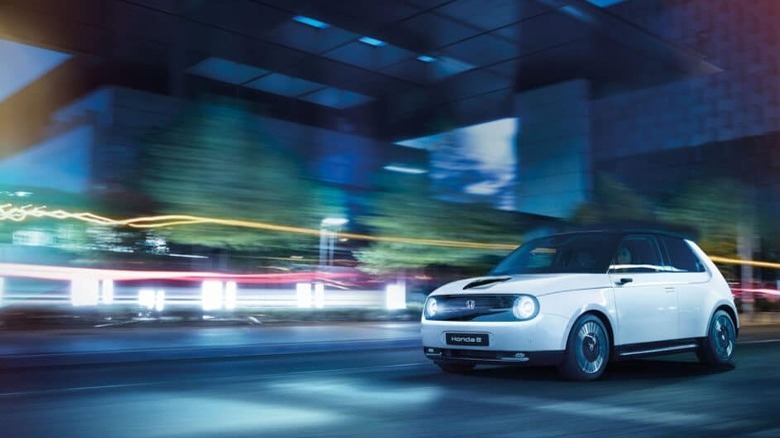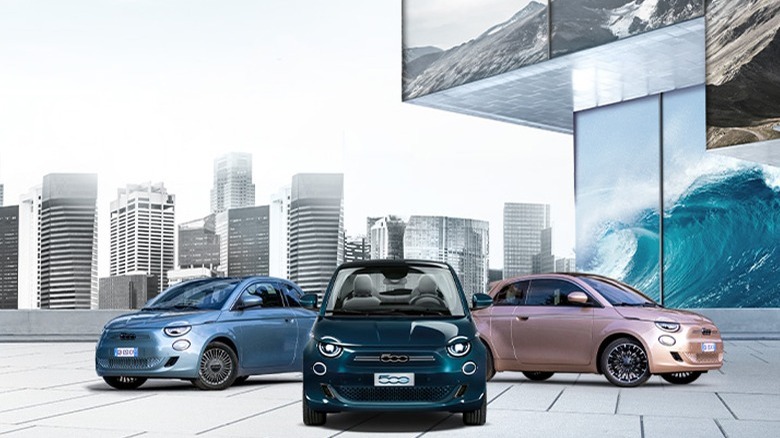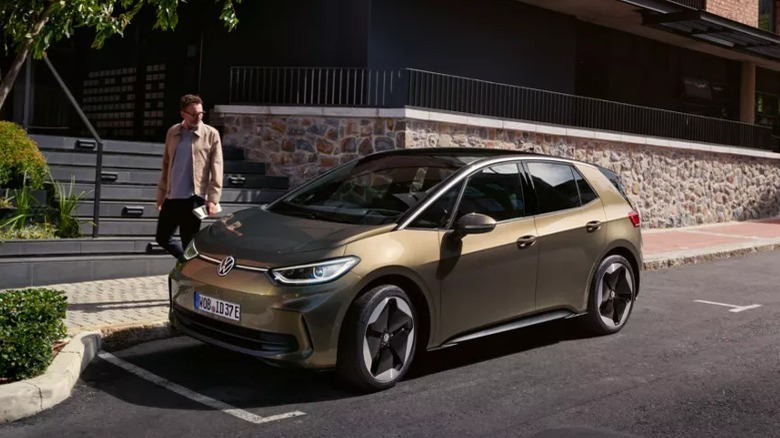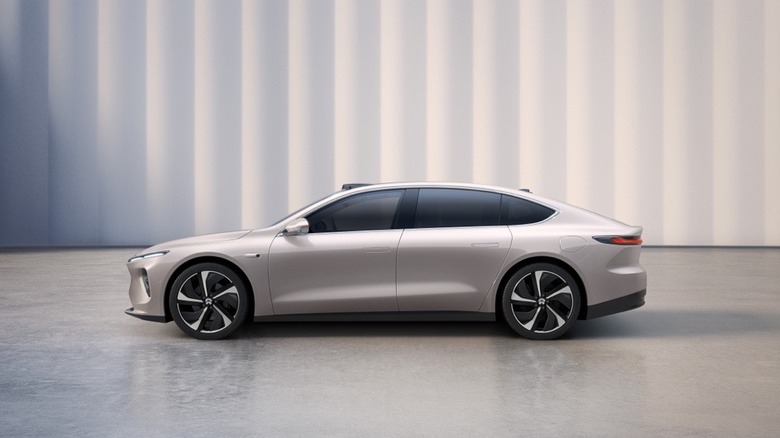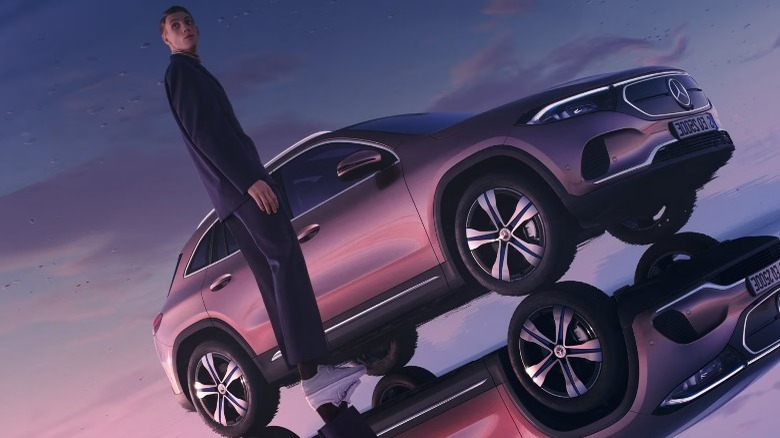5 Electric Cars We Wish Were Sold In The US
A veritable stable of Fords, Teslas, Hondas, and Chevys make up a huge selection of the American EV marketplace. In 2022, Tesla made up 64% of all new EV registrations, with Chevrolet and Ford coming in at a very distant second and third. As a result of these skewed figures, it's no wonder why many electric-centric automakers haven't dipped their toes into the U.S. market. While many prominent brands are exploring their EV lineup in the research and development labs, some of the electric platforms they offer haven't made their way to American showrooms just yet. Automakers like Mercedes-Benz and Volkswagen are still holding onto some of their EV designs, perhaps waiting for adoption levels among American drivers to hit certain internal target thresholds.
Indeed, according to a Sierra Club report, as many as 45% of dealerships across the country would outright refuse to sell EVs on their lots regardless of their access to them, while 66% don't currently stock EVs. Coupled with still middling adoption among consumers, it's no wonder why one brand continues to dominate the data sheet. Yet, there are some wonderful and unique EVs out there in the global marketplace that American drivers simply aren't getting the chance to see and explore. From innovations in the Chinese market (for reference, 25% of all cars sold in China in 2022 were EVs) to European automakers that offer expanded ranges in the EU, these are five EVs that we'd love to see land on American shores.
Honda e
The Honda e is a squat, Mini Cooper-esque EV that's a commuter vehicle for those living in the heart of their beloved urban metropolis. It would fit right at home in the heart of London, Munich, or Tokyo—all international destinations where drivers can get their hands on this diminutive spitfire. In fact, the Honda e was even named Germany's Car of the Year in 2021. To make the vehicle even more interesting to the outside observer, Formula 1's top earner and champion driver, Max Verstappen has weighed in on the e Limited Edition. It's "simply lovely, it has funky looks, a compact design, and is fun to drive," Verstappen offered, according to a Honda press release.
This small ride isn't going to blow anyone away with its performance standards, though. The e offers a range of just 137 miles, but with electric motor options that deliver either 134 brake horsepower or 152 brake horsepower, the small in stature e creates a surprising amount of acceleration force when called upon. As well, even with a range that lives in the shadow of the most pedestrian among EVs, the typical commuter won't need more than a fraction of this on a daily basis, making the car a great choice for those who primarily stick to driving around town for work or while running errands. The e doesn't show up in American car lots, but its unique style would make a significant splash if it ever did!
Fiat 500e
Fiat recently discontinued sales of its 500 lineup in the United States (in 2019). But this doesn't mean that the electrified 500e is any less worthy on American roads than its counterparts that are sold in the States. Much like some other vehicles that are built on smaller footprints, there's a unique charm to the Fiat 500 range, and the electrified model takes this yet another step further. The Fiat name is perhaps the most intertwined with the country that birthed the brand on this list. The Italian sensibility is therefore prominent in the 500e, and the car is responsive and stylistic in all the same ways as its gasoline-powered sibling.
Fortunately, for us, the 500e appears ready to reemerge in the American market for the upcoming 2024 model year, offering a slight reprieve from all the longing for peppy and versatile EVs that are (or in this case, once were) only available abroad. The new model year is set to sport a 117 horsepower motor coupled with a 32.3 kWh battery pack. This will give the 500e a 199-mile estimated range. A return for the Fiat name will bring a dynamic and incredibly fun car back to the American marketplace, underpinned by this modern, electrified update.
Volkswagen ID.3
Volkswagen is a prominent name in both automotive innovation and the EV revolution more specifically. VW's ID.4 will be a familiar name among American EV shoppers, but its smaller compatriot, the ID.3 is noticeably absent from the U.S. market. The car is reminiscent of the brand's much-loved Golf aesthetic but offers a new take on the body style to go along with the electrified platform. There are a number of trims available to buyers in the international market, with the ID.3 Tour Pro S build offering the largest battery capacity (77 kWh) and power output (204 PS/201 horsepower) combination. This build offers drivers a range of up to 340 miles and a best 0-62 mile per hour acceleration time of 7.3 seconds.
The ID.3 supports fast charging (as quick as 5% to 80% in 38 minutes with a DC3 125 kW charger) as well as a top speed of 99 miles per hour. As you might expect, these VWs are complete with the Volkswagen infotainment system supported on a 10-inch screen. The vehicle fits right in with VW's existing lineup, and it's frankly a shame that American drivers aren't able to experience the joys of this instant classic in the VW range.
NIO ET7
A thorough rehash of the Tesla platform, the Chinese NIO ET7 is a stylish EV with one standout feature — its sensor array, prominently mounted at the front edge of the car's roof. Combined with sensors elsewhere on the chassis, the NIO Aquila system includes 33 total sensors, including a LiDAR system and a variety of high-definition cameras and ultrasonic sensors designed to identify oncoming threats before they cause trouble. Performance-wise, the ET7 is underpinned by a massive, 150 kWh battery that stands prepared to offer a 1,000-kilometer range (621 miles). Similarly, the electric motor rockets the ET7 forward from 0-62 miles per hour in 3.8 seconds.
Inside, drivers will find the NOMI assistant that's able to converse with those inside the passenger compartment and offer a range of functionalities. You're also immersed in a surround sound environment as soon as you sit down inside the car. The 7.1.4 Dolby Atmos system runs 23 speakers throughout the cabin for the best in rider enjoyment.
Mercedes-Benz EQA
Finally, it seems that Mercedes-Benz has been holding out on eager American buyers as well. The EQA is a new platform that hit the European marketplace in the spring of 2021. It's built in the German city of Rastatt as well as in Beijing, signaling a utility in the Asian automotive space as well. Mercedes-Benz suggests a similarity with the GLA model that has touched down in U.S. dealerships, however, potentially hinting at a future arrival with a model year somewhere down the road.
The EQA is a compact SUV and stands as an entry-level EV from the luxury automaker. The vehicle sports an approximate charging time of just 32 minutes and a range of 529 kilometers (329 miles) on a full charge, however. These statistics make it a major contender for attention when it comes to shopping for a new EV, regardless of its price point (which is roughly €47,500, or $52,000 in Germany). Mercedes-Benz's EQA joins the ranks of other Mercedes models that sport smooth curvatures and athletic lines throughout the chassis. Inside the car, buyers can choose from a standard trim, or opt for the Electric Art or AMG Line upgrades that bring a variety of comfort enhancements and visual design changes to the cabin.

